7 Inspiring Influencer Marketing Campaign Examples for 2025
Discover top influencer marketing campaign examples to boost your strategy in 2025. Learn how successful brands are creating impactful campaigns.
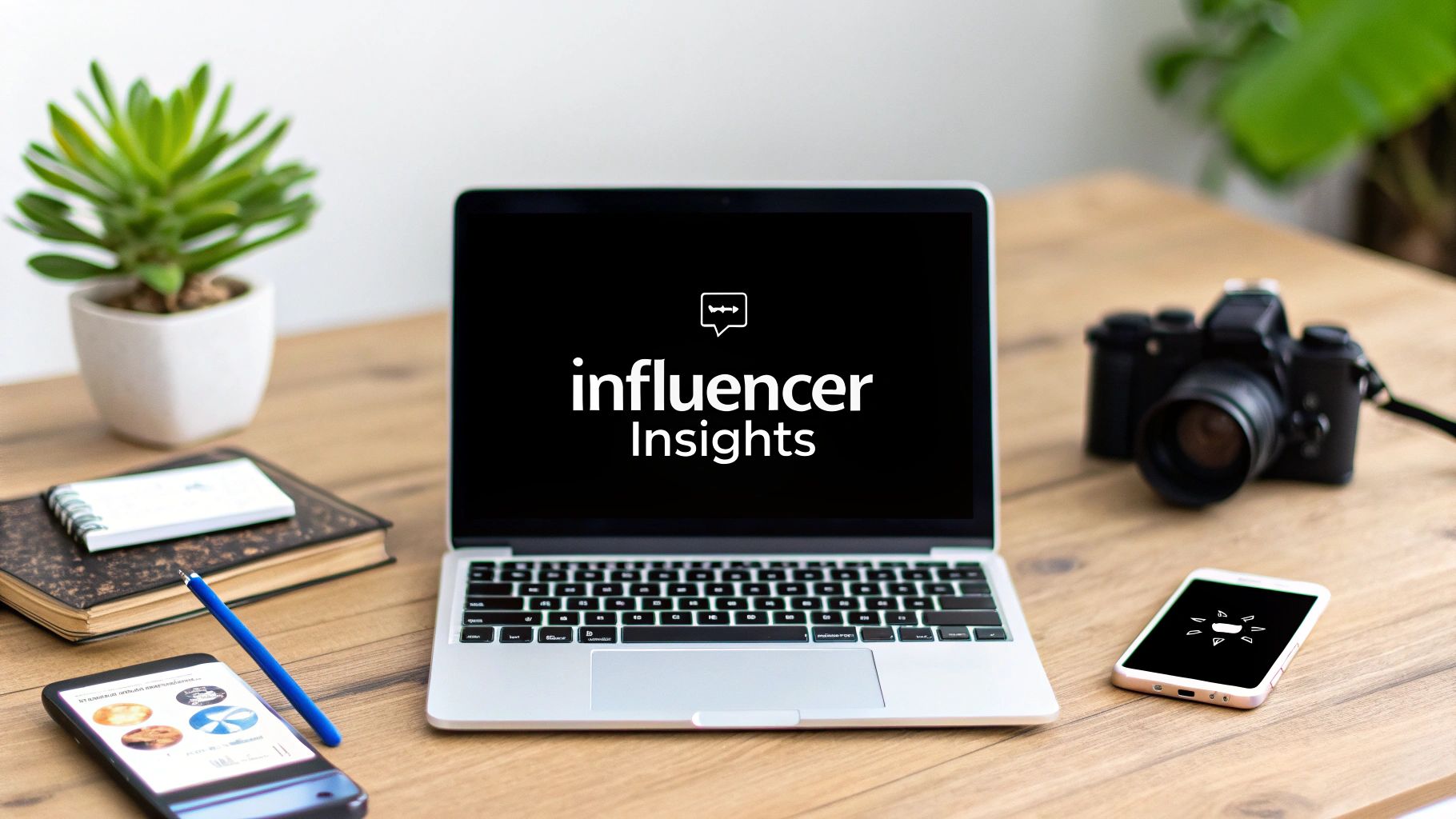
Finding effective influencer marketing campaign examples can be a challenge. Sifting through countless articles to find campaigns with real strategic depth, actionable takeaways, and replicable tactics often leads to outdated case studies or surface-level summaries. This guide cuts through the noise. We've compiled a curated list of the best platforms and resources where you can find detailed breakdowns of successful campaigns, complete with screenshots, direct links, and the specific metrics that matter.
This isn't just a list of feel-good success stories. It's a strategic toolkit designed to help you deconstruct what makes a campaign truly work. We will explore official case study libraries from platforms like Meta and Google, dive into curated databases from industry leaders, and even look at how top-tier management platforms showcase their client wins. For those wanting to first build a strong foundational knowledge, a resource like A Guide to Modern Influencer Marketing can provide invaluable context before diving into these specific examples.
Each entry in our list is designed to give you a behind-the-scenes look at high-performing collaborations. You will learn not just what brands did, but why they did it and how you can apply those same principles to your own marketing efforts, whether you're a brand manager, agency professional, or an aspiring creator.
1. TikTok Creative Center – Top Ads Dashboard
Before launching your next campaign, the best place to start is by analyzing what’s already succeeding. The TikTok Creative Center, specifically its Top Ads Dashboard, is an invaluable, free resource for deconstructing high-performing influencer marketing campaign examples directly on the platform. It's essentially an official, searchable library of the most effective ads, many of which are creator-led.
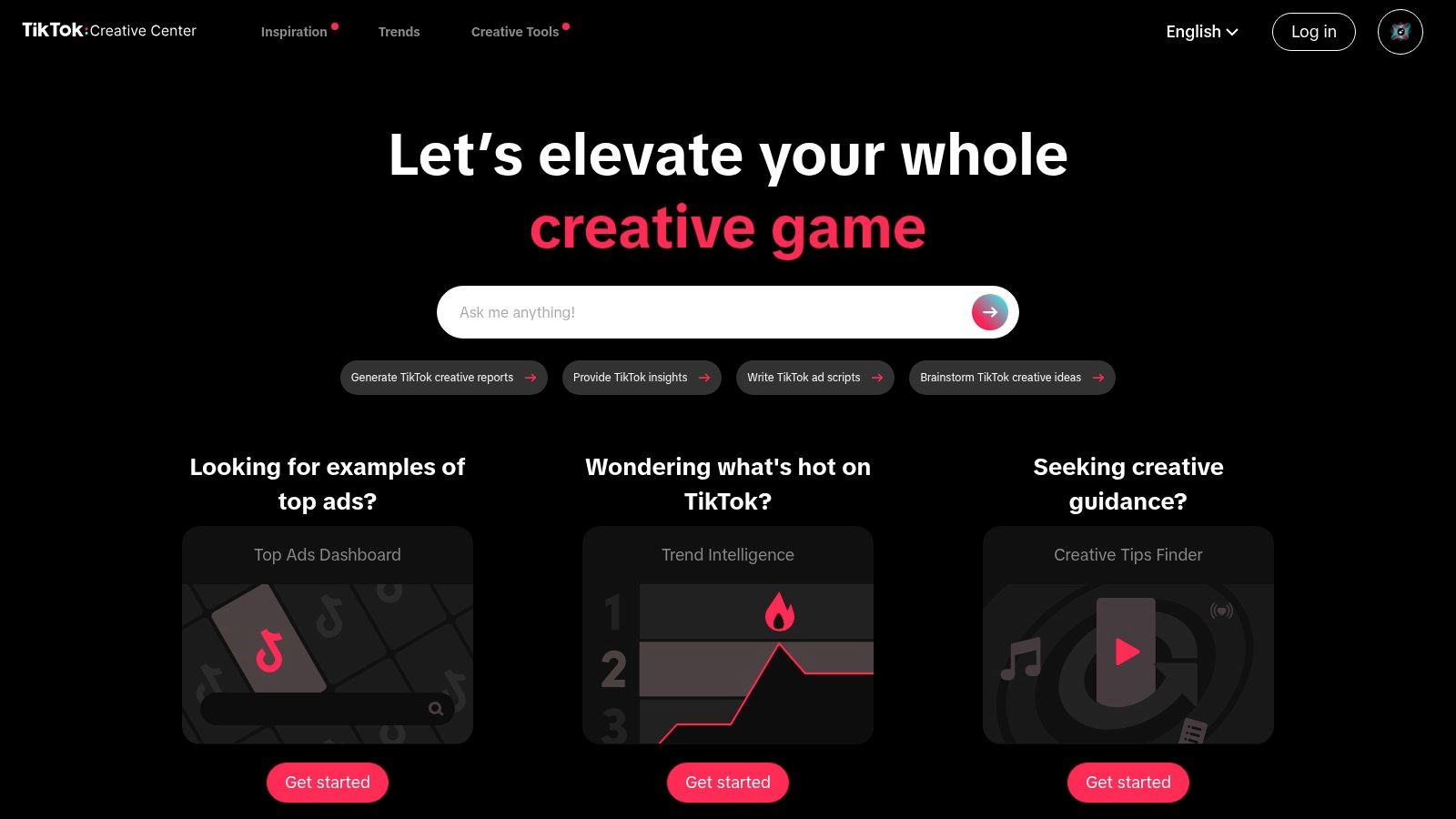
This tool moves beyond generic inspiration by providing granular data and powerful filtering capabilities. You can zero in on specific campaign elements to understand why they worked, making it a goldmine for strategic planning.
Why It’s an Essential Tool for Marketers
What makes the Creative Center unique is its official data. Unlike third-party tools that guess at performance, this dashboard provides TikTok's own analytics on top-performing creatives. You can see real-world engagement curves, click-through rates (CTR), and conversion rates (CVR), benchmarked against industry averages.
The platform is completely free to access, although you get more detailed analytics and features by logging in with a TikTok For Business account. The user interface is clean and intuitive, designed for quick searches and analysis.
How to Use It for Campaign Inspiration
To get the most out of the platform, use its robust filtering system. You can sort ads by industry, region, and campaign objective (like reach or conversions). This allows you to find direct competitors or analogous campaigns in other sectors.
- Filter by Objective: Is your goal brand awareness or direct sales? Select the corresponding objective to see influencer content tailored to that specific outcome.
- Analyze Engagement: Look at the "Ad Details" for any creative. Pay close attention to the engagement rate curve to see where viewers drop off or interact the most.
- Build a "Swipe File": Use the "Add to collection" feature to save compelling influencer ads. This helps you build a library of proven concepts to inspire your own creative briefs.
By studying these top-performing examples, you can identify patterns in hooks, calls-to-action, and storytelling formats that resonate with the TikTok audience, giving your own influencer campaigns a data-backed head start.
Website: https://ads.tiktok.com/business/creativecenter
2. Meta for Business – Advertising Case Studies (Facebook & Instagram)
For campaigns centered on Facebook and Instagram, Meta's own case study library is a must-visit resource. While not exclusively focused on influencers, it contains hundreds of official success stories, many of which detail powerful creator partnerships. This makes it an ideal place to find influencer marketing campaign examples that are backed by paid media and rigorous measurement.
This platform provides a transparent look into how brands leverage creators within the Meta ecosystem, offering strategic blueprints that combine authentic content with sophisticated ad targeting. It moves beyond vanity metrics to showcase tangible business results.
Why It’s an Essential Tool for Marketers
The key advantage of Meta's library is its focus on measurable outcomes backed by first-party data. Case studies often include specific metrics like return on ad spend (ROAS), brand lift, and conversion rates, providing credible benchmarks for your own goals. You can see precisely how a creator's content was amplified with paid ads to achieve a specific business objective.
Access to this library is completely free, requiring no special accounts or logins. The platform is built to highlight the effectiveness of its ad tools, making the user experience centered on discovering and understanding successful strategies.
How to Use It for Campaign Inspiration
Leverage the powerful filtering system to find case studies directly relevant to your needs. You can sort by industry, business size, region, and campaign objective, making it easy to analyze what similar brands have accomplished.
- Filter by Industry & Objective: Looking for CPG brands that used influencers for conversions? Apply these filters to narrow down the most relevant examples and deconstruct their approach.
- Study the "Why It Worked" Section: Each case study typically has a breakdown of the strategy. Pay close attention to this to understand the creative choices and targeting methods.
- Identify Creator-Led Ad Formats: Look for examples that specifically mention Branded Content Ads or partnerships. Note how brands use formats like Reels and Stories with influencers to drive results. You can learn more about Meta advertising strategies on createinfluencers.com.
By analyzing these official case studies, you can build a strong business case for your influencer campaigns, blending organic creativity with a data-driven paid media strategy to maximize impact.
Website: https://www.facebook.com/business/success
3. Think with Google – Creator/Influencer Case Studies (YouTube)
For brands focused on video-first strategies, Google's own editorial platform provides a masterclass in effective YouTube collaborations. Think with Google features in-depth articles and case studies that break down some of the best influencer marketing campaign examples on YouTube, offering a strategic perspective backed by Google's immense data resources.
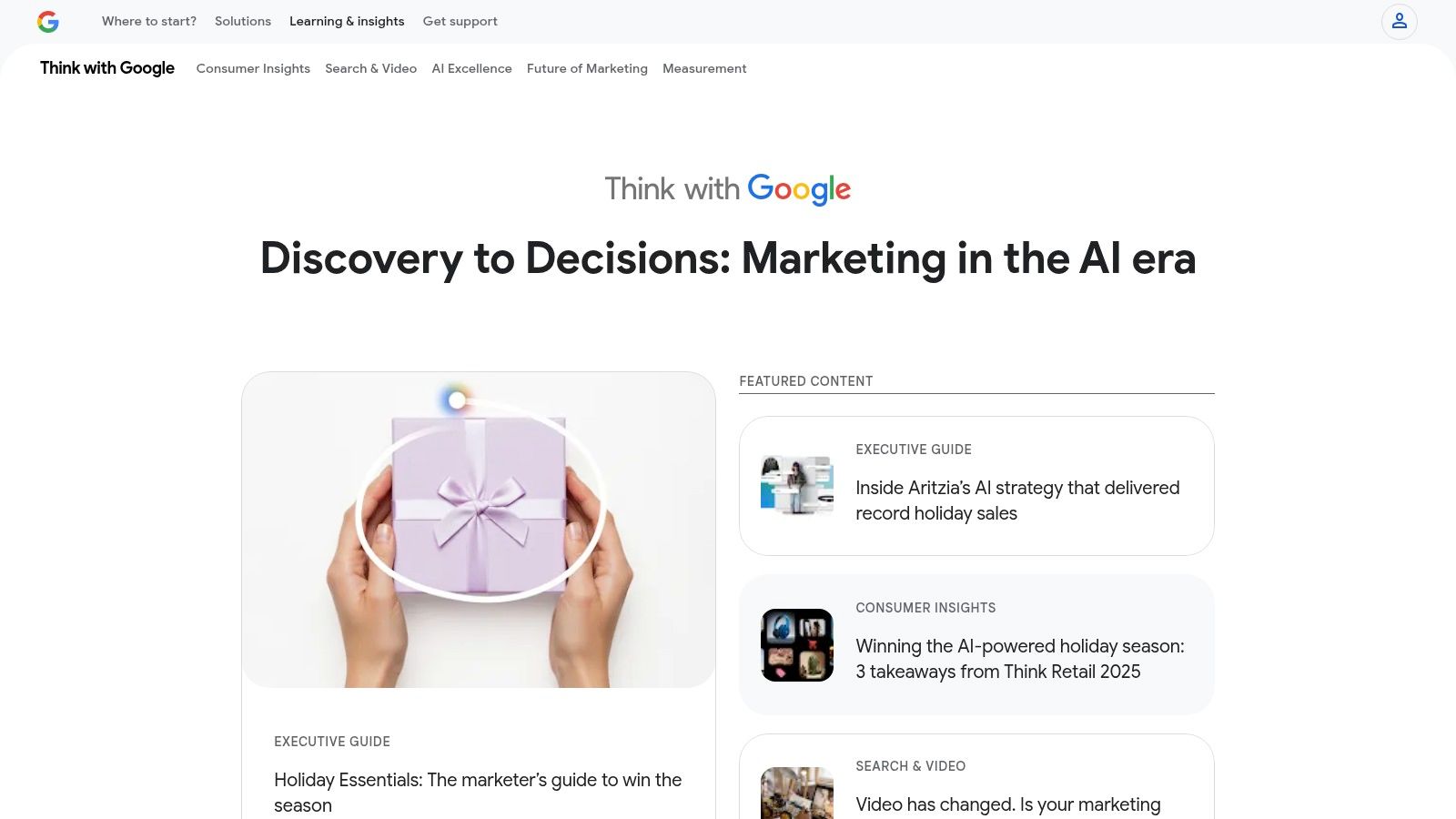
Unlike a raw ad library, this resource curates high-impact campaigns and explains the "why" behind their success. It's less about finding a specific creative and more about understanding the strategic framework that leads to measurable results like brand lift and conversions.
Why It’s an Essential Tool for Marketers
The credibility of Think with Google is its biggest asset. The insights are published directly by Google and YouTube, providing authoritative analysis on what works on their platform. You get access to detailed write-ups that often include specific metrics like view-through rates (VTR), brand awareness lift, and click-through rates (CTR), which are rarely shared publicly.
The platform is completely free to access, presenting its findings through well-written articles and research papers. While it’s not a searchable database like other tools, its editorial approach ensures that the examples featured are both current and strategically significant.
How to Use It for Campaign Inspiration
Leverage Think with Google as a source for strategic frameworks rather than just creative ideas. Use the site's search bar with terms like "creator collaboration," "influencer marketing," or "YouTube Shorts campaign" to find relevant case studies.
- Study the Strategic Rationale: For each case study, focus on the brand's objective and why they chose a specific creator or format. The articles often detail the creative brief and the reasoning behind the collaboration.
- Analyze Performance Metrics: Look for case studies that share hard numbers. Understanding how a campaign drove a 15% lift in ad recall or a 10% increase in purchase intent provides a tangible benchmark for your own goals.
- Discover Format-Specific Insights: Find articles that break down best practices for different formats, such as long-form sponsored videos versus YouTube Shorts. This helps you tailor your influencer strategy to the specific placement you're targeting.
By reading these deep-dive analyses, you can move beyond surface-level trends and build influencer campaigns based on proven, data-supported strategies directly from the source.
Website: https://www.thinkwithgoogle.com
4. Influencer Marketing Hub – Curated Campaign Examples and Case Studies
While platform-specific tools provide deep data, a broad-spectrum view is crucial for holistic strategy. The Influencer Marketing Hub serves as a comprehensive third-party library, offering curated lists of influencer marketing campaign examples across nearly every platform and industry imaginable. It's an essential resource for seeing how different strategies perform in various contexts.
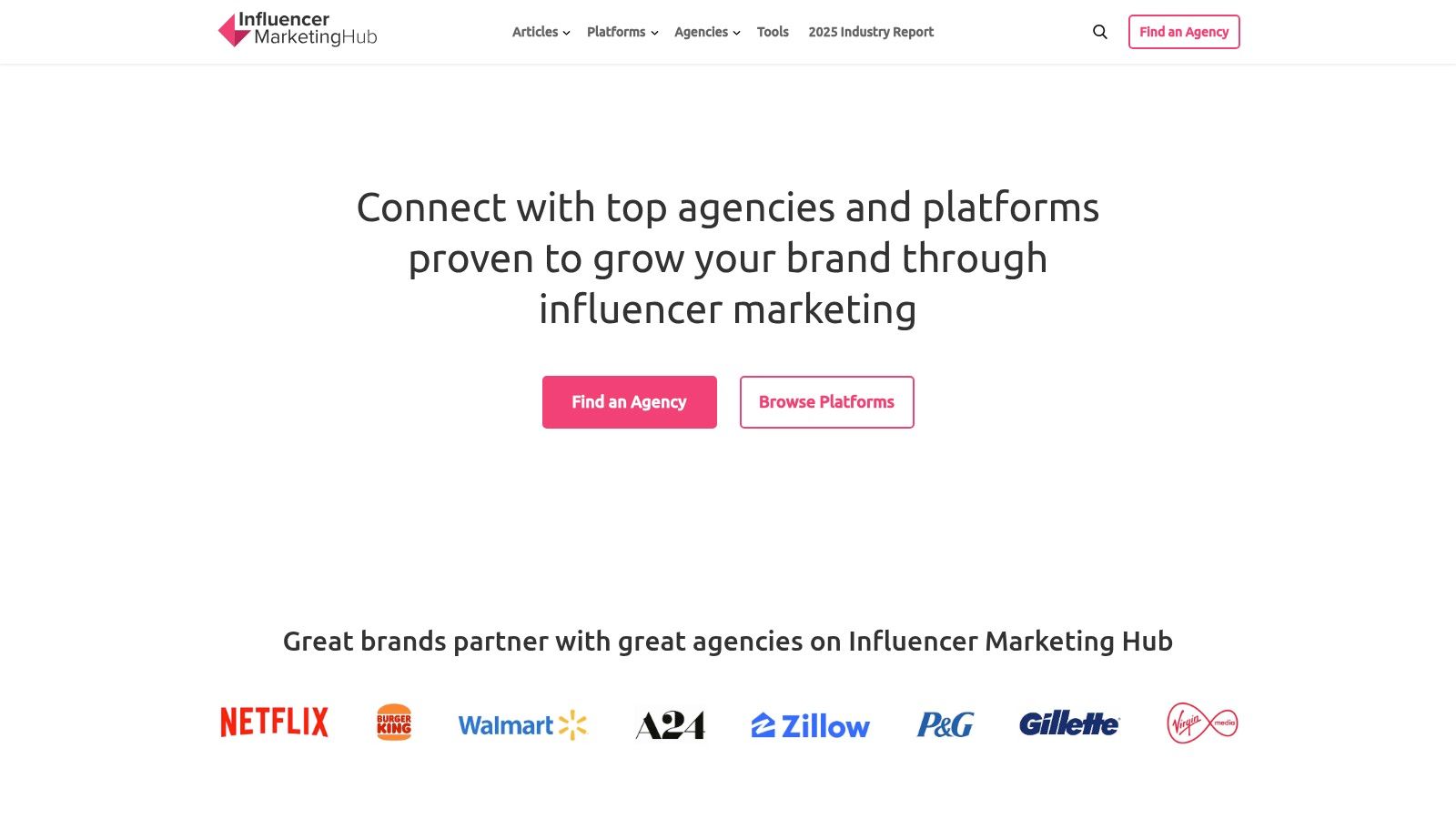
This platform excels at providing quick, scannable inspiration. Unlike a raw data dashboard, the Hub presents campaigns as digestible case studies, breaking down the strategy, execution, and outcomes in a narrative format that is easy to understand and learn from.
Why It’s an Essential Tool for Marketers
The Hub’s primary advantage is its breadth and curation. Instead of you needing to hunt for examples, their team compiles and regularly updates lists covering everything from TikTok and fashion to B2B and automotive campaigns. While it is a secondary source and metrics can sometimes be limited, the strategic overviews are invaluable.
The website is completely free to access, functioning as a content-rich blog and resource center. The user experience is straightforward, with campaigns neatly organized into articles and categories, making it simple to find relevant examples without a steep learning curve. The content also offers insights that you can adapt for your own campaigns, which you can explore in more depth by checking out our blog on influencer strategies.
How to Use It for Campaign Inspiration
Leverage the Hub’s categorical organization to streamline your research. Start with broad searches and then narrow down to find campaigns that mirror your goals.
- Explore by Platform or Niche: Use the site’s search or navigation to find articles like "Best Fashion Influencer Campaigns" or "TikTok Campaign Examples." This gives you a curated shortlist of relevant case studies.
- Identify Cross-Platform Ideas: See how a beauty brand's campaign on Instagram was adapted for YouTube. The Hub makes it easy to compare multi-platform strategies from a single brand.
- Analyze the "Why": For each example, focus on the analysis provided. The articles often explain the strategic thinking behind the campaign, giving you insights into the brand's objectives and why they chose a particular influencer or approach.
By using the Hub as a starting point, you can quickly gather a wide range of ideas and identify high-level strategic patterns before diving into more granular data-driven tools.
Website: https://influencermarketinghub.com
5. Aspire (Influencer Marketing Platform) – Customer Stories
For marketers planning comprehensive, multi-stage influencer programs, Aspire's customer stories section offers a behind-the-scenes look at operational success. These case studies go beyond single viral posts to showcase how brands build and scale entire creator ecosystems, from product seeding and organic content generation to paid amplification and affiliate marketing.
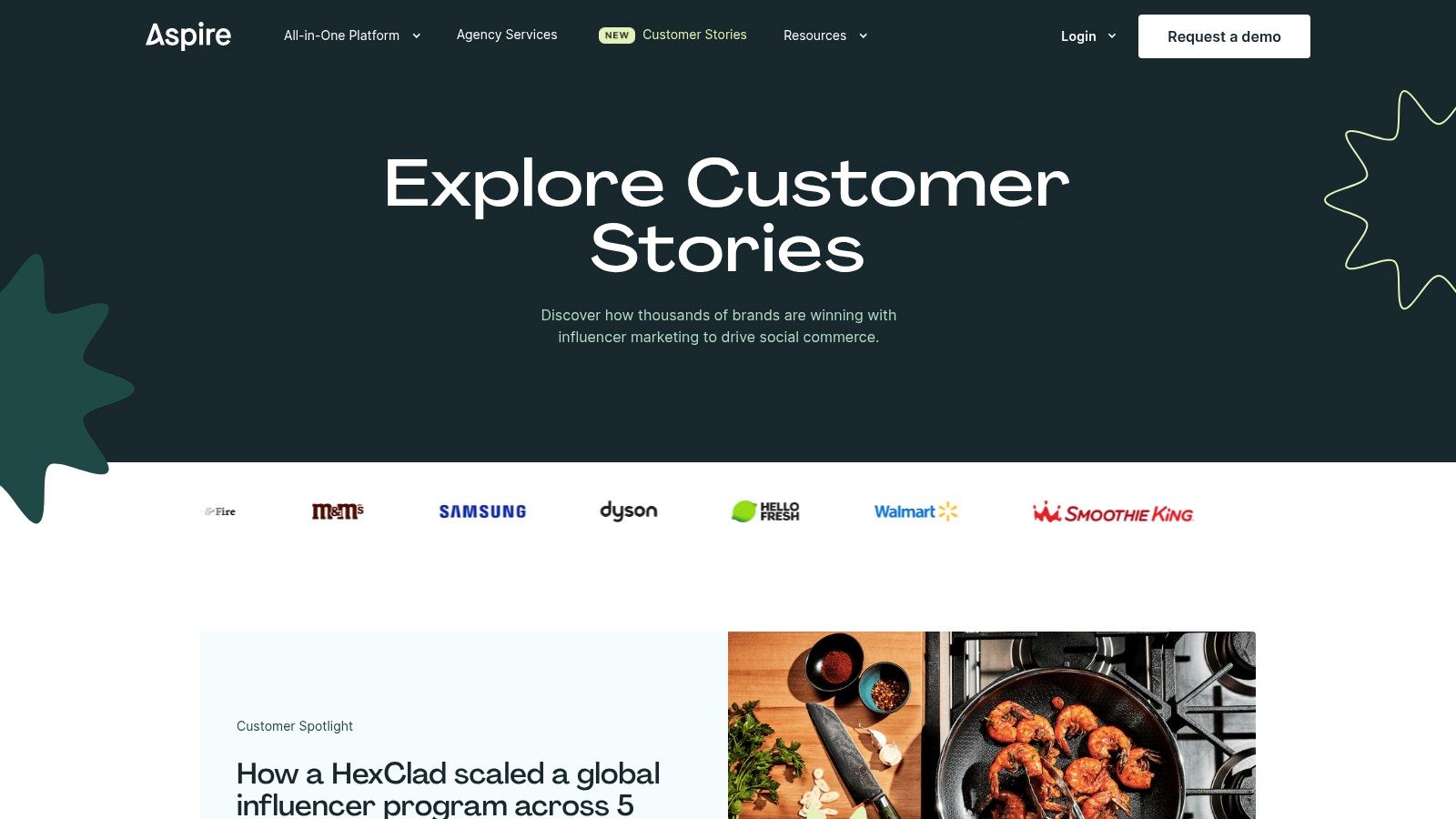
This resource is less about individual creative examples and more about the strategic framework behind sustained influencer programs. It provides tangible influencer marketing campaign examples that detail workflow, creator activation at scale, and the integration of user-generated content (UGC) into a brand’s broader marketing mix.
Why It’s an Essential Tool for Marketers
Aspire’s case studies are uniquely valuable for their focus on the operational side of influencer marketing. They don't just show the final ad; they reveal the process, including how many creators were activated, the volume of content generated, and the resulting business impact, like conversion lift or return on ad spend (ROAS). This makes it an excellent resource for modeling a program's potential ROI.
While the case studies are designed to promote Aspire's platform, they provide free, actionable insights into campaign structure. The examples illustrate how to blend organic and paid strategies, a crucial element for scaling modern influencer marketing efforts.
How to Use It for Campaign Inspiration
Drill down into the case studies to extract a blueprint for your own program's logistics and measurement framework. The filters allow you to find brands in your niche, such as Beauty, Food & Beverage, or Home & Garden.
- Model Your Workflow: Analyze how brands like Buffy or M&M'S structure their campaigns from creator discovery to content approval and payment. This can inform your own operational planning.
- Set Realistic KPIs: Use the metrics provided (e.g., impressions, pieces of content, CPA) as benchmarks to set realistic goals for your own campaigns.
- Learn to Scale: Pay attention to how brands manage hundreds of creators simultaneously for product seeding or UGC campaigns. Aspire’s guides provide practical tips on how to implement similar strategies.
By deconstructing these real-world programs, you can build a more strategic, scalable, and measurable influencer marketing engine, moving from one-off collaborations to a continuous, performance-driven channel.
Website: https://www.aspire.io/stories
6. GRIN (Creator Management Platform) – Case Studies + Pricing Overview
For brands ready to scale their creator programs, GRIN’s case studies offer a masterclass in building a comprehensive, long-term influencer marketing engine. This creator management platform shares detailed success stories from ecommerce, CPG, and apparel brands, moving beyond single-campaign inspiration to showcase entire program frameworks. These are some of the most transparent influencer marketing campaign examples available from a platform provider.
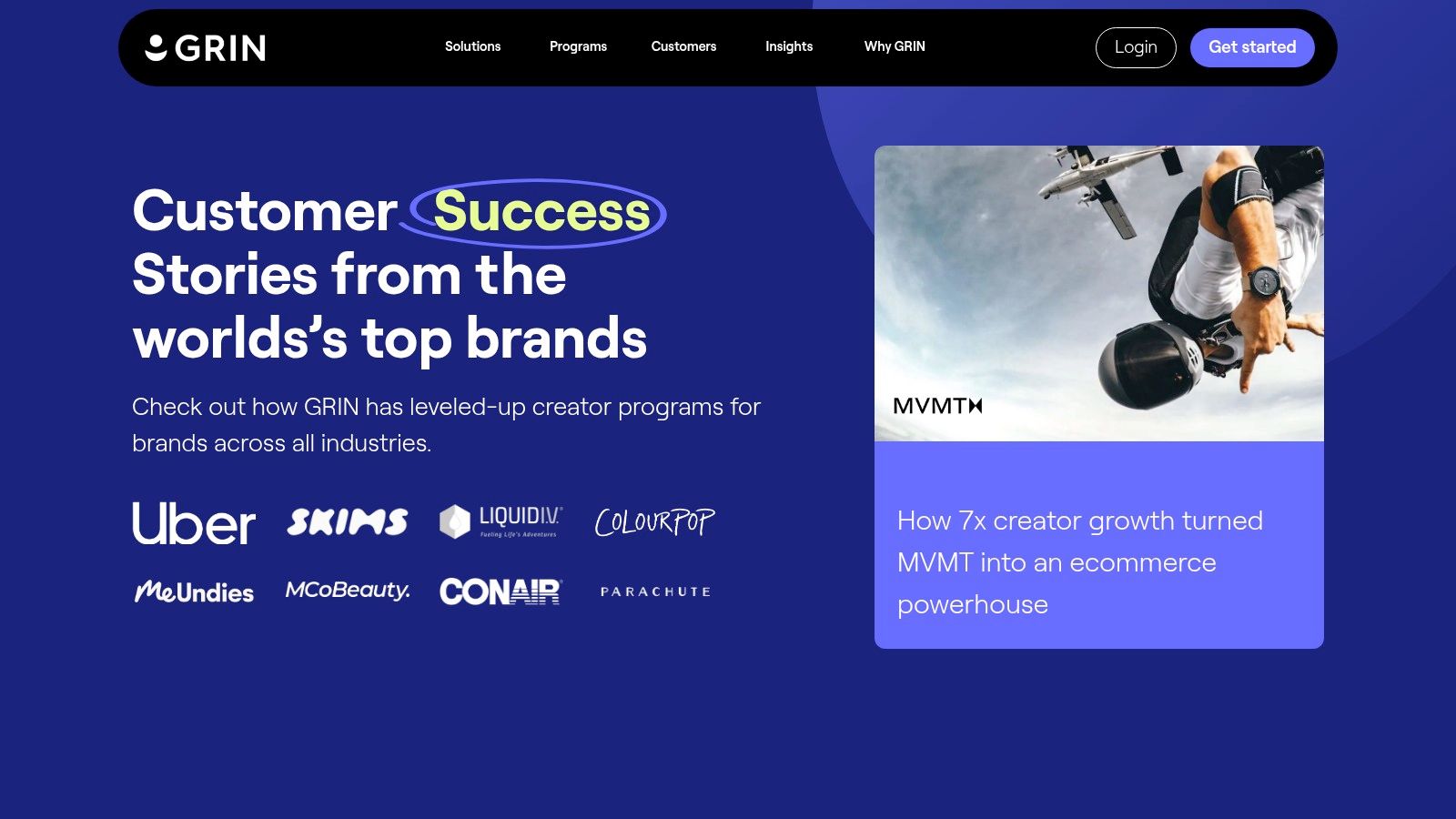
The resources on GRIN's site are less about individual viral videos and more about the operational strategy behind sustainable influencer programs. They detail everything from creator recruitment and product seeding to affiliate conversions and calculating ROI, providing a blueprint for marketers looking to build an in-house system.
Why It’s an Essential Tool for Marketers
What makes GRIN's case studies so valuable is their focus on measurable, business-centric outcomes. They provide concrete metrics like the number of creators onboarded, content output generated, and tangible conversion benchmarks. This is especially useful for marketers who need to justify their influencer marketing spend with hard data and prove its impact on the bottom line.
Access to the case studies is completely free, but understanding the full platform requires a sales call for a demo and pricing. The case studies often highlight the platform's strong ecommerce integrations (like Shopify and WooCommerce), demonstrating how brands use GRIN to manage ambassador and affiliate workflows seamlessly. While some user feedback mentions contract and reliability concerns, the success stories provide a clear view of the platform's intended power.
How to Use It for Campaign Inspiration
Use GRIN’s case studies to reverse-engineer a scalable influencer program. Instead of just looking for creative ideas, focus on the operational structure and growth funnels these brands implemented.
- Map Program Progression: Analyze how brands like Lume or SKIMS progressed from initial gifting campaigns to structured, performance-based partnerships. This provides a roadmap for evolving your own creator relationships.
- Identify Relevant KPIs: Look at the specific metrics highlighted in each case study. Use these as a benchmark to set realistic goals for your own campaigns, whether it’s creator acquisition rate or affiliate-driven revenue.
- Structure Your Tech Stack: The case studies implicitly show how a creator management platform integrates with other ecommerce tools. This can help you understand the workflow and justify the need for a centralized system as you scale.
By studying these end-to-end program examples, you can learn how to build the infrastructure needed to support, manage, and grow a high-performing team of brand advocates.
Website: https://grin.co/case-studies
7. Amazon (Books & Audiobooks with Case Studies)
For marketers who prefer structured, in-depth learning, Amazon offers a vast library of books and audiobooks dedicated to deconstructing successful influencer marketing campaign examples. Instead of fleeting digital content, these resources provide consolidated frameworks, playbooks, and vetted case studies that can be studied, annotated, and shared within a team.
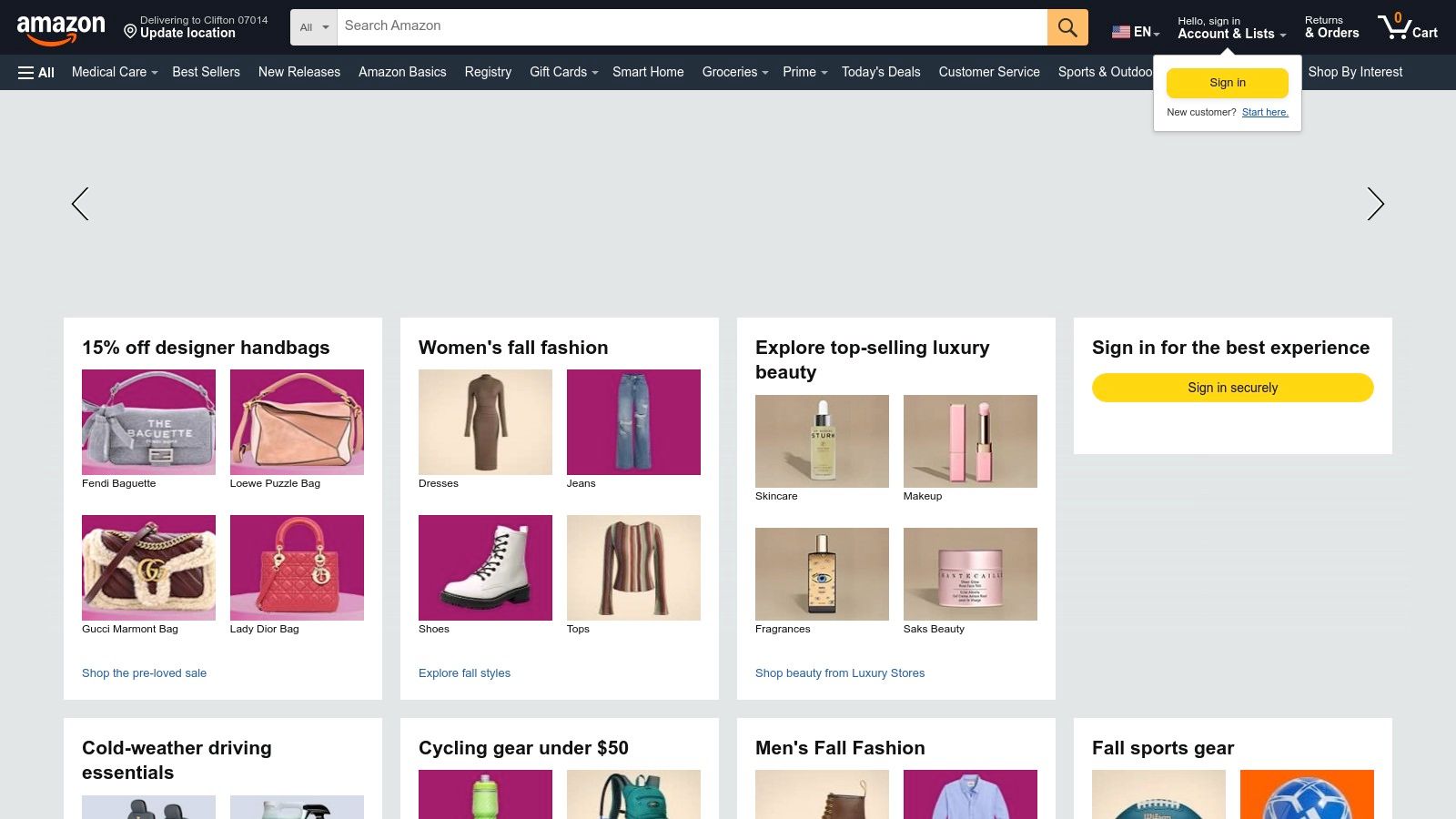
This approach is ideal for building foundational knowledge and developing strategic documents. Books offer a focused, distraction-free environment to absorb complex strategies and often include step-by-step templates that are perfect for internal training and aligning marketing departments.
Why It’s an Essential Tool for Marketers
What makes books from Amazon a unique resource is the expert curation and structured guidance they provide. Unlike a blog post, a well-researched book offers a comprehensive A-to-Z playbook that connects strategy to execution. Many titles dedicate entire chapters to detailed case studies, breaking down campaign goals, creator selection, execution, and ROI.
These resources are available in multiple formats, including print, Kindle, and Audible, catering to different learning preferences. The one-time cost of a book provides a permanent resource, though the main drawback is that print content can lag behind fast-moving digital trends, requiring you to cross-reference insights with current platform data.
How to Use It for Campaign Inspiration
To find the best resources, use specific search terms like "influencer marketing case studies" or "creator economy strategy." Look at publication dates and reader reviews to ensure the content is relevant and well-regarded.
- Build a Foundational Library: Purchase a few highly-rated books to create a shared resource for your team. This helps standardize language and strategy.
- Focus on Frameworks: Pay attention to chapters that outline repeatable frameworks for campaign planning, creator outreach, and performance measurement. These are timeless assets.
- Annotate and Extract Templates: Use physical highlighters or digital annotation tools to mark key takeaways. Extract any templates or checklists provided for use in your own campaign briefs and reports.
By combining the deep strategic knowledge from books with real-time data from platforms like TikTok's Creative Center, you can build a robust and well-rounded approach to your influencer marketing efforts.
Website: https://www.amazon.com
Influencer Marketing Campaigns: 7-Source Comparison
| Resource | Implementation Complexity 🔄 | Resource Requirements ⚡ | Expected Outcomes 📊 | Ideal Use Cases 💡 | Key Advantages ⭐ |
|---|---|---|---|---|---|
| TikTok Creative Center – Top Ads Dashboard | Low; easy web-based filtering and browsing | Low; free access but requires login for full use | High; current, creator-led TikTok ad insights | Benchmarking TikTok creator campaigns | Official, free source; clear niche filters |
| Meta for Business – Advertising Case Studies | Moderate; requires searching and analysis | Low; free access with extensive case library | High; measurable paid influencer campaign results | Studying paid Facebook & Instagram influencer media | Credible, first-party data; vertical-specific |
| Think with Google – Creator/Influencer Case Studies | Moderate; reading in-depth articles | Low; freely accessible editorial content | Moderate; detailed YouTube creator campaign insights | Understanding YouTube creator marketing strategies | Research-backed, diverse video formats |
| Influencer Marketing Hub – Curated Campaign Examples | Low; straightforward browsing and comparison | Low; free third-party aggregation | Moderate; broad but varying depth and metrics | Cross-platform influencer campaign inspiration | Wide industry coverage; easy to scan examples |
| Aspire (Influencer Marketing Platform) – Customer Stories | Moderate; requires platform contact for pricing | Moderate; sales contact needed | High; practical workflow and campaign metrics | Modeling influencer programs and scaling | Workflow-focused; combines organic and paid content |
| GRIN (Creator Management Platform) – Case Studies + Pricing Overview | Moderate; sales call needed for pricing details | Moderate; requires onboarding and contract review | High; detailed ecommerce influencer campaign metrics | Ecommerce influencer program planning | Varied US brand examples; transparent pricing tiers |
| Amazon (Books & Audiobooks with Case Studies) | High; requires reading and study | Medium; purchase required for books or audiobooks | Moderate; structured guidance but may lag in updates | Deep study and internal training | Vetted frameworks; multiple reading formats |
From Inspiration to Implementation: Your Next Steps
The diverse influencer marketing campaign examples we've explored prove one thing: there is no single formula for success. From the raw, trend-driven energy of TikTok to the polished, community-centric stories on Instagram and the in-depth narratives on YouTube, the most effective campaigns are those that align authentically with the platform, the creator, and the brand's core message. They move beyond simple product placements to forge genuine connections and deliver tangible value.
These case studies, sourced from tools like the TikTok Creative Center and Meta's Business Hub, reveal a common thread. Success hinges on a deep understanding of the target audience and granting creators the freedom to communicate in their own voice. The most memorable collaborations feel less like advertisements and more like trusted recommendations from a friend.
Turning Insights into Actionable Strategy
As you move from inspiration to execution, the key is to translate these high-level takeaways into a concrete plan. The tools we've covered, such as GRIN and Aspire, are not just for finding influencers; they are comprehensive platforms designed to streamline every phase of your campaign, from discovery and outreach to contract management, content approval, and performance analytics.
Choosing the right tool depends entirely on your specific goals and resources:
- For Competitive Research & Trend Spotting: Start with free resources like the TikTok Creative Center and Think with Google to understand what’s currently resonating in your niche.
- For All-in-One Campaign Management: If you're managing multiple creators and need a robust system for workflow, payments, and ROI tracking, platforms like GRIN and Aspire offer enterprise-level solutions.
- For Deep Strategic Learning: Don’t underestimate the power of in-depth resources. The case studies from Influencer Marketing Hub and specialized books on Amazon provide nuanced strategies that can inform your entire marketing philosophy.
Before you invest in any platform, critically assess your needs. Are you looking for micro-influencers to build brand trust, or a macro-influencer for a massive awareness push? Do you need a tool to manage a one-off campaign or a long-term ambassador program? Answering these questions will guide you to the most effective and cost-efficient solution.
Ultimately, the most successful influencer marketing campaign examples are a testament to the power of strategic, human-centered marketing. The landscape is constantly shifting, so staying ahead of the curve is paramount. To ensure your influencer marketing campaigns are future-proof and capitalize on emerging opportunities, it's essential to stay informed about the evolving digital landscape. Explore the critical social media trends for 2025 to adapt your strategy effectively. By combining the right tools with a creative, authentic approach, you can build partnerships that not only drive results but also create lasting brand affinity.
Ready to pioneer the next wave of digital influence? While traditional campaigns are powerful, the future lies in creating unique, AI-driven personalities that captivate audiences. With CreateInfluencers, you can design, develop, and deploy your own AI influencers, opening up limitless creative possibilities without the complexities of human management. Explore the new frontier of marketing and build your virtual star today at CreateInfluencers.